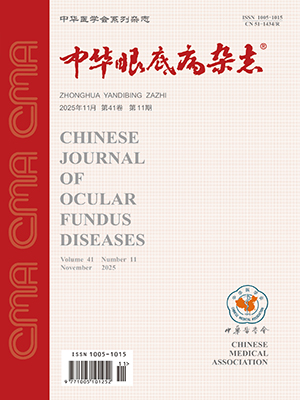| 1. |
张妍, 贾超, 张方顺, 等. 原发性闭角型青光眼患者超声乳化手术治疗的临床效果及对患者预后的影响[J]. 中国现代药物应用, 2022, 16(5): 58-60. DOI: 10.14164/j.cnki.cn11-5581/r.2022.05.020.Zhang Y, Jia C, Zhang FS, et al. Clinical effect of clear lens phacoemulsification for primary angle- closure glaucoma and its influence on prognosis of patients[J]. Chin J Mod Drug Appl, 2022, 16(5): 58-60. DOI: 10.14164/j.cnki.cn11-5581/r.2022.05.020.
|
| 2. |
Penteado RC, Zangwill LM, Daga FB, et al. Optical coherence tomography angiography macular vascular density measurements and the central 10-2 visual field in glaucoma[J]. J Glaucoma, 2018, 27(6): 481-489. DOI: 10.1097/IJG.0000000000000964.
|
| 3. |
Yousefi S, Sakai H, Murata H, et al. Asymmetric patterns of visual field defect in primary open-angle and primary angle-closure glaucoma[J]. Invest Ophthalmol Vis Sci, 2018, 59(3): 1279-1287. DOI: 10.1167/iovs.17-22980.
|
| 4. |
陈聪, 张祎草, 常新奇, 等. 经睫状体扁平部玻璃体腔穿刺抽液联合前房重建术治疗恶性青光眼的疗效观察[J]. 临床医学, 2022, 42(3): 51-52. DOI: 10.19528/j.issn.1003-3548.2022.03.019.Chen C, Zhang YC, Chang XQ, et al. The efficacy of transciliary flattening vitreous cavity aspiration combined with anterior chamber reconstruction in the treatment of malignant glaucoma[J]. Clin Med, 2022, 42(3): 51-52. DOI: 10.19528/j.issn.1003-3548.2022.03.019.
|
| 5. |
余学清, 魏伟, 张旭. 原发性闭角型青光眼黄斑区视网膜血管密度的相关性研究[J]. 江西医药, 2020, 55(6): 631-635. DOI: 10.3969/j.issn.1006-2238.2020.06.001.Yu XQ, Wei W, Zhang X. Relationship of retinal blood vessel density in macular region of primary angle-closure glaucoma[J]. Jiangxi Med J, 2020, 55(6): 631-635. DOI: 10.3969/j.issn.1006-2238.2020.06.001.
|
| 6. |
中华医学会眼科学分会青光眼学组, 中国医师协会眼科医师分会青光眼学组. 中国青光眼指南(2020年)[J]. 中华眼科杂志, 2020, 56(8): 573-586. DOI: 10.3760/cma.j.cn112142-20200313-00182.Glaucoma Group of Ophthalmology Branch of Chinese Medical Association, Glaucoma Group of Ophthalmologist Branch of Chinese Medical Doctor Association. Guidelines for glaucoma in China (2020)[J]. Chin J Ophthalmol, 2020, 56(8): 573-586. DOI: 10.3760/cma.j.cn112142-20200313-00182.
|
| 7. |
赵灿. 青光眼视野缺损分级方法[J]. 中华实验眼科杂志, 2013, 31(3): 292-297. DOI: 10.3760/cma.j.issn.2095-0160.2013.03.020.Zhao C. Staging visual field damage in glaucoma[J]. Chin J Exp Ophthalmol, 2013, 31(3): 292-297. DOI: 10.3760/cma.j.issn.2095-0160.2013.03.020.
|
| 8. |
Rao HL, Dasari S, Riyazuddin M, et al. Diagnostic ability and structure-function relationship of peripapillary optical microangiography measurements in glaucoma[J]. J laucoma, 2018, 27(3): 219-226. DOI: 10.1097/IJG.0000000000000873.
|
| 9. |
Cao D, Yang D, Huang Z, et al. Optical coherence tomography angiography discerns preclinical diabetic retinopathy in eyes of patients with type 2 diabetes without clinical diabetic retinopathy[J]. Acta Diabetol, 2018, 55(5): 469-477. DOI: 10.1007/s00592-018-1115-1.
|
| 10. |
胡依博, 沈策英, 张培. 光学相干断层扫描仪检测视网膜神经纤维层厚度在慢性原发性闭角型青光眼早期诊断中应用[J]. 山西医药杂志, 2021, 50(10): 1630-1632. DOI: 10.3969/j.issn.0253-9926.2021.10.014.Hu YB, Shen CY, Zhang P. Application of optical coherence tomography to detect retinal nerve fiber layer thickness in early diagnosis of chronic primary angle-closure glaucoma[J]. Shanxi Med J, 2021, 50(10): 1630-1632. DOI: 10.3969/j.issn.0253-9926.2021.10.014.
|
| 11. |
王伟, 王娈, 郭莹. 定量分析原发性急性闭角型青光眼首次发作后视盘周围毛细血管密度参数变化[J]. 河北医药, 2021, 43(17): 2610-2613. DOI: 10.3969/j.issn.1002-7386.2021.17.011.Wang W, Wang L, Guo Y. Quantitative analysis of the changes of capillary density parameters around the optic disc after the first attack of primary acute angle-closure glaucoma[J]. Hebei Med J, 2021, 43(17): 2610-2613. DOI: 10.3969/j.issn.1002-7386.2021.17.011.
|
| 12. |
李红月, 惠瑜, 孙海霞, 等. 原发性开角型及慢性闭角型青光眼患者视盘毛细血管密度和视野缺损的关联性研究[J]. 中国眼耳鼻喉科杂志, 2019, 19(6): 400-404. DOI: 10.14166/j.issn.1671-2420.2019.06.010.Li HY, Hui Y, Sun HX, et al. The relationship between optic disc capillary density and mean defect of visual field open-angle and angle-closure glaucoma[J]. Chin J Ophthalmol and Otorhinolaryngol, 2019, 19(6): 400-404. DOI: 10.14166/j.issn.1671-2420.2019.06.010.
|
| 13. |
Jo YH, Sung KR, Yun SC. The relationship between peripapillary vascular density and visual field sensitivity in primary open-angle and angle-closure glaucoma[J]. Invest Ophthalmol Vis Sci, 2018, 59(15): 5862-5867. DOI: 10.1167/iovs.18-25423.
|
| 14. |
叶雪萍, 陈小舒, 周瑞芳. 农村地区中老年青光眼患者自我管理的现状及其影响因素分析[J]. 广西医学, 2021, 43(23): 2886-2890. DOI: 10.11675/j.issn.0253-4304.2021.23.25.Ye XP, Chen XS, Zhou RF. Current situation of self-management of middle-aged and elderly glaucoma patients in rural areas and analysis of their influencing factors[J]. Guangxi Med J, 2021, 43(23): 2886-2890. DOI: 10.11675/j.issn.0253-4304.2021.23.25.
|
| 15. |
Bae HW, Lee N, Lee HS, et al. Systemic hypertension as a risk factor for open-angle glaucoma: a meta-analysis of population-based studies[J/OL]. PLoS One, 2014, 9(9): e108226[2014-09-25]. https://pubmed.ncbi.nlm.nih.gov/25254373/. DOI: 10.1371/journal.pone.0108226.
|
| 16. |
江方方, 邢懿, 姜波, 等. 老年女性原发性开角型青光眼的影响因素分析[J]. 实用老年医学, 2020, 34(10): 4. DOI: 10.3969/j.issn.1003-9198.2020.10.013.Jiang FF, Xing Y, Jiang B, et al. Analysis of the influencing factors of primary open-angle glaucoma in elderly women[J]. Prac Geriat, 2020, 34(10): 4. DOI: 10.3969/j.issn.1003-9198.2020.10.013.
|
| 17. |
崔淑婷, 刘成生, 刘宏. 晶体植入联合前段玻璃体切除术对恶性青光眼患者的临床疗效及其预后影响因素分析[J]. 医学临床研究, 2019, 36(3): 474-476. DOI: 10.3969/j.issn.1671-7171.2019.03.020.Cui ST, Liu CS, Liu H. Clinical efficacy and prognostic factors of lens implantation combined with anterior vitrectomy for malignant glaucoma[J]. J Clin Res, 2019, 36(3): 474-476. DOI: 10.3969/j.issn.1671-7171.2019.03.020.
|
| 18. |
王晓蕾, 孙兴怀. 视野半侧缺损的原发性开角型青光眼视网膜微循环改变的研究[J]. 中华眼科杂志, 2021, 57(3): 201-206. DOI: 10.3760/cma.j.cn112142-20201102-00734.Wang XL, Sun XH. Retinal vessel density in primary open-angle glaucoma with a hemifield defect[J]. Chin J Ophthalmol, 2021, 57(3): 201-206. DOI: 10.3760/cma.j.cn112142-20201102-00734.
|
| 19. |
陈小玲, 焦亚, 贺文山, 等. 光相干断层扫描血管成像对开角型青光眼患者视网膜血管密度和视网膜厚度的测量[J]. 中华实验眼科杂志, 2020, 38(5): 396-401. DOI: 10.3760/cma.j.cn115989-20200326-00208.Chen XL, Jiao Y, He WS, et al. Retinal vessel density and retinal thickness as measured using optical coherence tomography angiography in open angle glaucoma[J]. Chin J Exp Ophthalmol, 2020, 38(5): 396-401. DOI: 10.3760/cma.j.cn115989-20200326-00208.
|
| 20. |
卢尹悦, 黄清清, 缪晓翠. 原发性急性闭角型青光眼急性发作期视网膜血管密度特征分析[J]. 创伤与急诊电子杂志, 2023, 11(1): 23-27. DOI: 10.16746/j.cnki.11-9332/r.2023.01.004.Lu YY, Huang QQ, Miao XC. Characteristics of retinal vascular density in acute primary angle-closure glaucomaduring attack phase[J]. J Trauma Emerg, 2023, 11(1): 23-27. DOI: 10.16746/j.cnki.11-9332/r.2023.01.004.
|




